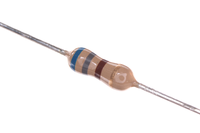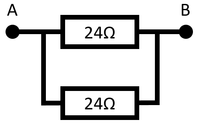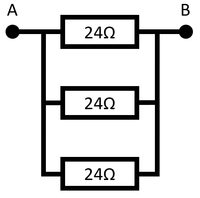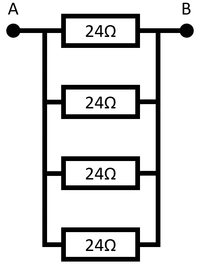Difference between revisions of "Resistor"
(→Resistors in Series) |
(→Resistors in Series) |
||
| Line 34: | Line 34: | ||
===Resistors in Series=== | ===Resistors in Series=== | ||
: Adding [[resistor]]s in [[Series Circuit|series]] increases the [[Electrical Resistance|resistance]] in the [[circuit]]. | : Adding [[resistor]]s in [[Series Circuit|series]] increases the [[Electrical Resistance|resistance]] in the [[circuit]]. | ||
| + | : The [[Electrical Resistance|resistance]] of each [[resistor]] can be added together. | ||
{| class="wikitable" | {| class="wikitable" | ||
|- | |- | ||
Revision as of 15:21, 27 February 2019
Contents
Key Stage 3
Meaning
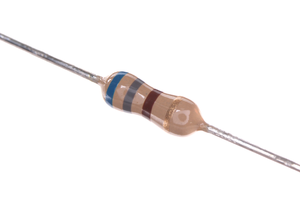
A picture of a resistor.
A resistor is a component in an electrical circuit which makes it difficult to electricity to pass through it.
About Resistors
- A resistor is a component designed to have a particular resistance.
- Resistors are added to circuits to control the current which will pass through for a certain potential difference.
- The greater the resistance of a resistor the smaller the current will be.
- The resistance of a resistor can be found by attaching an ammeter in series with the resistor and a voltmeter in parallel with the resistor.
- All components in a circuit act as resistors, including wires. The longer a wire the more resistance it will have to a current.
| A resistor. | The symbol for a resistor. |
Key Stage 4
Meaning

The symbol for a resistor.
A resistor is a component in an electrical circuit which makes it difficult to electricity to pass through it.
About Resistors
- A resistor is a component designed to have a particular resistance.
- Resistors are added to circuits to control the current which will pass through for a certain potential difference.
- The greater the resistance of a resistor the smaller the current will be.
- The resistance of a resistor can be found by attaching an ammeter in series with the resistor and a voltmeter in parallel with the resistor.
- All components in a circuit act as resistors, including wires. The longer a wire the more resistance it will have to a current.
Resistors in Series
- Adding resistors in series increases the resistance in the circuit.
- The resistance of each resistor can be added together.
| The resistance between points A and B is:
5Ω. | |
| The resistance between points A and B is:
2Ω + 5Ω = 7Ω | |
| The resistance between points A and B is:
2Ω + 5Ω + 9Ω = 16Ω |
Resistors in Parallel
NB: You only need to know what happens with identical resistors in parallel.
- When identical resistors are added in parallel there are more paths for the electricity so the resistance is reduced.
| Two identical resistors in Parallel circuit gives twice the number of paths, so has half the resistance.
The resistance between points A and B is 12Ω. |
Three identical resistors in Parallel circuit gives three times the number of paths, so has a third of the resistance.
The resistance between points A and B is 8Ω. |
Four identical resistors in Parallel circuit gives four times the number of paths, so has a quarter of the resistance.
The resistance between points A and B is 6Ω. |
